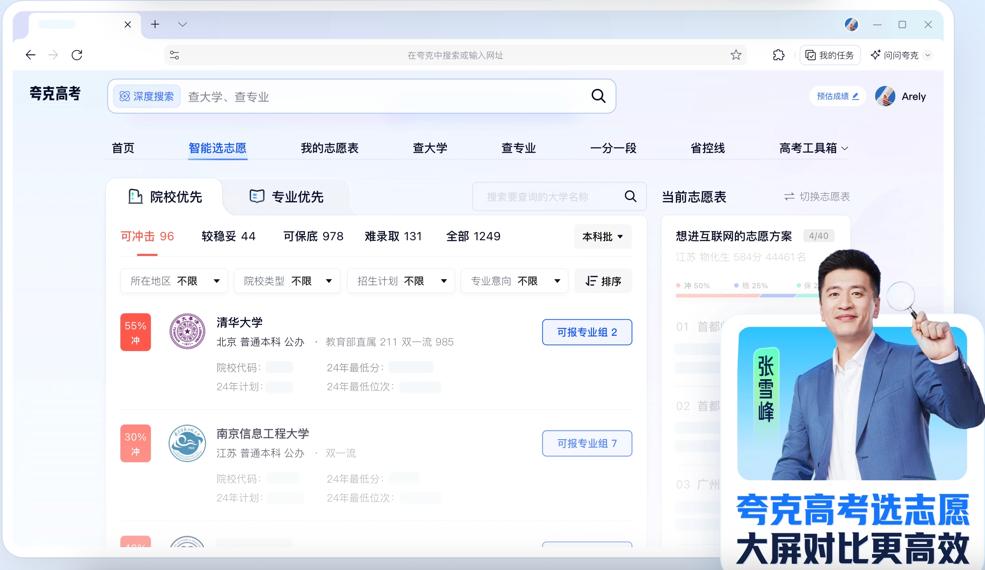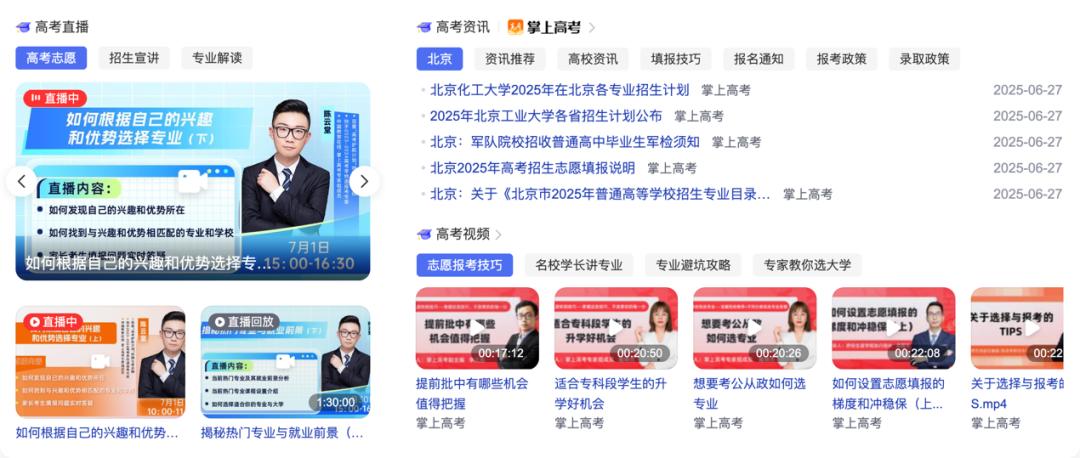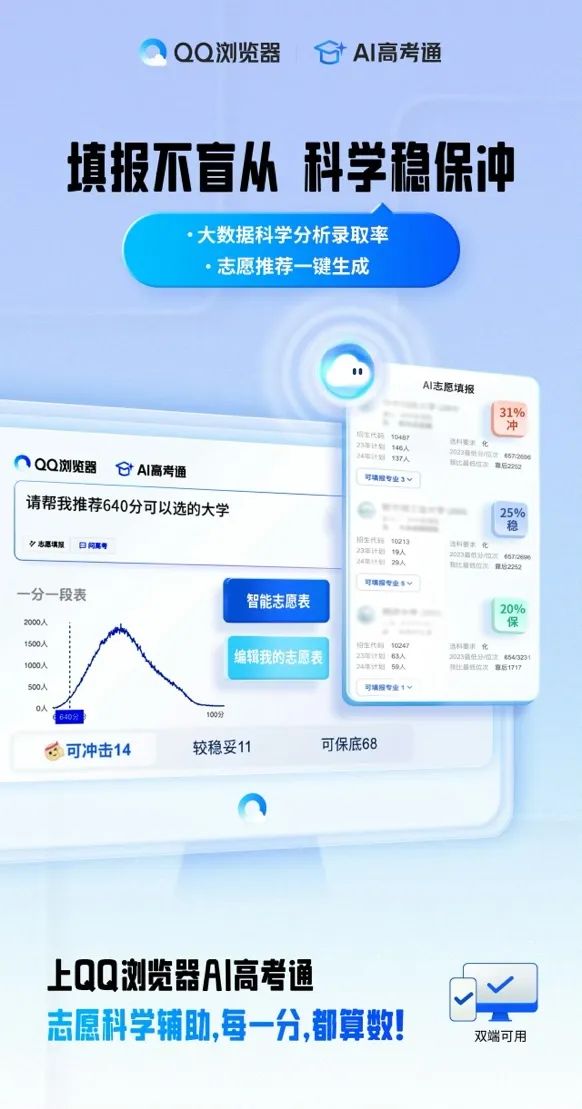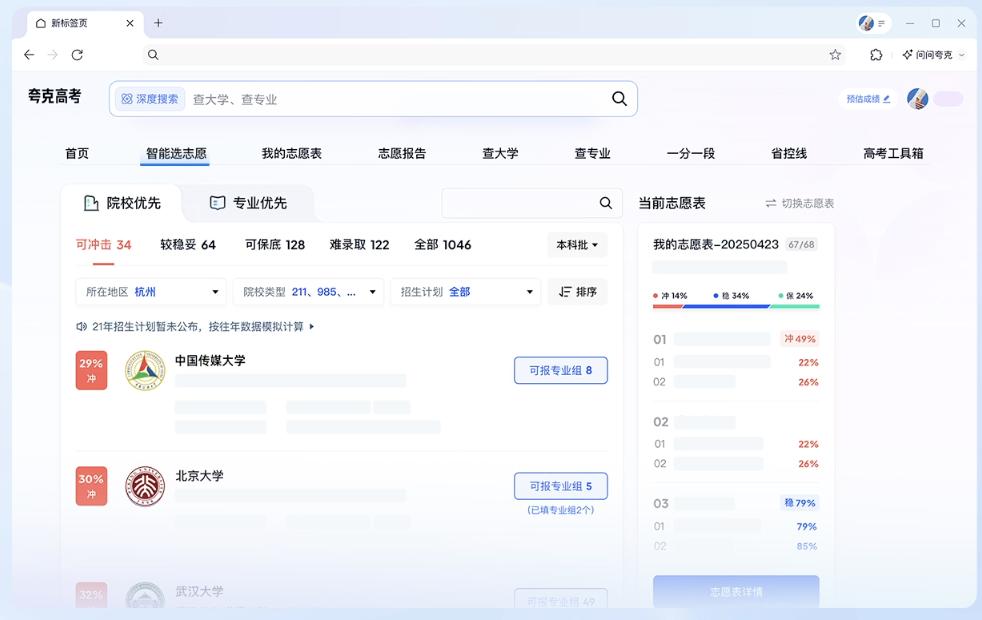Can Large AI Models Replace 'Zhang Xuefeng' in the College Application Process?
![]() 07/02 2025
07/02 2025
![]() 604
604

By Erfeng
Source: Node Finance
Each year, following the release of college entrance exam scores, tens of millions of students and parents face another grueling challenge—completing college applications.
This year, AI has fully infiltrated this field, with numerous internet giants and education companies introducing intelligent application products to advise students on college and major selection.
According to iMedia Research, China's paid market size for college application services was approximately 950 million yuan in 2023, with nearly 90% of students willing to use such services. It is projected that the market size will rise to 1.09 billion yuan by 2025.
High-fee manual application planning experts are in short supply. For instance, the company founded by renowned online education blogger Zhang Xuefeng offers one-on-one application services that can cost up to tens of thousands of yuan. This has given rise to more than a thousand related enterprises. Faced with this vast traffic pool, internet giants have also announced their plans for AI-based college application services, a scenario with rigid demand.
01 Who is Competing for this AI High Ground in 'Filling Out Applications'?
Currently, the operators behind AI college application tools on the market are broadly categorized into three groups: internet giants (like Baidu, Alibaba, Tencent, ByteDance, Zhihu, etc.), large education companies (such as Zuoyebang, Xueersi, etc.), and vertical volunteer service companies.
Their product entry points and functional features vary in focus. Most large companies embed application assistants within their own apps or browsers, such as Baidu App's 'Baidu College Entrance Exam', Alibaba's Quark App's 'Quark College Entrance Exam', and Tencent QQ Browser's 'AI College Entrance Exam'.

Image source: Quark College Entrance Exam official website
Education companies often launch application functions within their learning apps or mini-programs, such as Zuoyebang's 'Application' and Gaotu Classroom's application assistant. Some platforms opt for cooperation rather than self-development. For example, ByteDance and Zhihu directly accessed China Education Online's 'Online College Entrance Exam' mock application system this year, providing users with a mock application entry.
According to Node Finance's observation, these tools all support students in quickly generating a 'three-tier' recommendation list based on their province, subject combination, and scores. This includes the 'impact' tier (reach schools), 'stable' tier (safe schools), and 'guarantee' tier (backup schools/majors), along with corresponding admission probability predictions.
For instance, Quark's 'Intelligent Application Selection' function allows students to input their province, subjects, and scores to receive a one-click list of 'impact', 'stable', and 'guarantee' schools and majors, with each major labeled with admission probability. Students can further input preference information such as regional preferences, professional interests, graduation plans, career inclinations, and family budgets to generate a more personalized application report and consult with the built-in AI model.
According to Quark's official news, it launched the country's first large college application model this year, deeply learning from a vast amount of knowledge in the application filling field. The generated application plans are relatively detailed. Tests have shown that it can produce a 15-20 page application plan report within 5-10 minutes, encompassing sections on student situation analysis, application strategy, application list analysis, and risk warnings. Interestingly, Quark also engaged Zhang Xuefeng as the spokesperson for Quark College Entrance Exam, adding another layer of industry endorsement to the product.

Image source: Baidu College Entrance Exam official website
This year, Baidu launched the 'Baidu College Entrance Exam' column, covering modules such as AI Application Assistant, 'AI Chat on Application', and college entrance exam big data.
Baidu's Application Assistant primarily provides services in the form of dialogue. Students can create multiple application plans (convenient for simulating different scores or multiple students), view results from different models during the interaction, and utilize tools like 'employment prospects comparison' to aid in decision-making. Additionally, the Baidu College Entrance Exam platform has introduced a college entrance exam live streaming room, aggregating live broadcasts and experience sharing from university admissions offices and senior students to offer users real-time consultation opportunities.
However, from an actual experience perspective, the specific recommendations given by such large model-driven agents are relatively concise by default. In contrast, application tools from companies like Zuoyebang, Gaotu, and NetEase Youdao are more akin to data-driven models, providing comprehensive school screening and intelligent recommendations, and generally supporting further dialogue with AI.
It's worth mentioning that unlike the free strategy of large companies, some third-party products adopt a 'basic functions free + advanced functions paid' model. For example, some platforms only display a limited number of recommended schools for free, and users need to purchase a membership to unlock all application plans. Membership fees range from 99 yuan to several hundred or even thousands of yuan.
According to Node Finance's observation, all AI application assistants emphasize 'massive data + intelligent recommendation' in terms of functionality, but each has its own strengths in user experience: some prioritize report depth, such as Quark providing detailed customized application reports; some stress interactive convenience, like Tencent's dialogue agent that instantly answers various application queries; others highlight tool integration, such as Baidu's one-stop service that combines query, comparison, live Q&A, etc. For students, these tools lower the threshold for information search and plan formulation, functioning to a certain extent as the 'AI version of application planners' to swiftly screen out alternative plans.
02 The Business Calculations Behind the Clustering of Large Companies
Despite appearing 'unprofitable', large companies are competing to invest in application tools, with clear motivations behind this.
On one hand, college application filling is a high-traffic area, with related search views measured in the tens of billions. Whoever can first provide useful tools will have the opportunity to establish high-frequency connections with a vast user base.
For Baidu, Alibaba, Tencent, and others, this is an excellent opportunity to acquire new users at a low cost. Node Finance believes that, strategically speaking, application filling is merely the starting point. By serving the college entrance exam population, these platforms can extend their service reach to university studies, postgraduate exams, employment, and other aspects in the future, fostering long-term user retention and forming an ecological closed loop in the education field.
On the other hand, launching AI application assistants is also a 'double harvest' of data and technology. In the application filling scenario, massive real user data is of great value for the training and iteration of AI models—information such as students' scores, preferences, and selection behaviors can help large models continuously learn how to understand complex tasks, adapt to admission rules in different regions, and identify user preferences, thereby enhancing the decision-making capabilities of the models.
Compared to daily casual chat and question-answering, college application tasks pose higher requirements for AI, necessitating both understanding of multi-round questioning and access to vast structured data. This is precisely used to test and refine the capabilities of AI agents.
As for the technical threshold, industry evaluations are actually not high. Most internet companies already have accumulations in search, big data, and AI algorithms. They only need to integrate publicly available data such as past college admission scores, professional information, and enrollment policies into the database, and then utilize large models for human-computer dialogue and recommendation calculations.
Therefore, we can see that many companies swiftly launched related products before this year's college entrance exam season. Some even held press conferences, placed splash screen ads, and invited celebrity endorsements, rapidly seizing land in the education field with the aid of this AI boom.
On the surface, most of these tools are free and do not directly generate revenue, but their 'invisible benefits' are reflected in traffic acquisition, data precipitation, model validation, and showcasing the company's AI capabilities and brand reinforcement.
03 Data Differences + Black Box Algorithms, Can AI Recommendations Be Trusted?
Faced with the endless emergence of 'AI application teachers', can students truly rest easy and leave the application entirely to machines?
Node Finance believes that AI application tools can only serve as an aid for now and cannot fully replace professional human judgment. Although these products possess powerful information integration and rapid analysis capabilities, they still have notable shortcomings in reliability and personalization.
Firstly, the recommended results given by different platforms vary significantly, and the algorithms are not transparent. For instance, after inputting the same province, subjects, and scores, different AI assistants generally calculate similar provincial rankings for students, but the generated 'impact, stable, guarantee' school lists are vastly different, leaving people confused.

Image source: QQ Browser official Weibo
Node Finance's actual testing also found that under the same conditions, the overlap rate of application plans recommended by tools such as Quark, Baidu, and Tencent AI College Entrance Exam is very low. The reason for this phenomenon lies in the varying focuses of the models and algorithms used by each platform. Different models weigh admission probability and school matching differently, inevitably leading to different outputs.
At the same time, there are also disparities in the underlying data dimensions of each company. Some only refer to admission data from the past 1-2 years, while others may include a longer period or even individual anomalous data, which can lead to substantial differences in recommended schools for the same score.
Secondly, issues of data accuracy and timeliness also cast doubt on the reliability of AI recommendations. Although each platform claims that the data sources used come from authoritative channels (such as the Ministry of Education's Sunshine College Entrance Exam Information Platform, university admission websites, etc.), errors may still occur during the crawling, integration, and updating processes.
Some AI assistants have made mistakes such as recommending schools without admission plans, ignoring geographical restrictions, or even suggesting obviously unreasonable options like Tsinghua or Peking University to students ranked in the top four or five thousand. This often stems from underlying data that is not comprehensive or authoritative enough, and when large models generate content, they may 'hallucinate' and output non-existent school and major information.

Image source: Quark College Entrance Exam official website
College application filling is a scenario with extremely low fault tolerance. However, currently, some AI products still possess outdated or flawed data. According to Beijing News, one AI miscalculated a student's ranking by tens of thousands compared to real data, resulting in recommended reach schools that were completely beyond the student's actual level. Additionally, some systems did not fully consider changes in the new college entrance exam policy and still advised students to 'obey adjustments' to avoid slipping, whereas in fact, under the new model in some provinces, the 'adjustment' option no longer exists.
Furthermore, AI is still far from experienced human consultation in terms of personalized matching. Application planners often engage in lengthy one-on-one communication with student families to understand various aspects such as the student's personality, hobbies, family background, and future aspirations, and then provide a customized plan based on a multi-year accumulated database of college majors and employment data.
Current AI products are also attempting to work in this direction, for example, by offering MBTI personality tests, Holland Vocational Interest Inventory, and multiple rounds of questioning to simulate 'customized applications'. However, from a practical experience perspective, many AI questions are templated and superficial—they simply inquire about intended cities, preferred major categories, whether to take the graduate exam or go abroad, acceptable tuition ranges, physical restrictions, etc.
True personalization is often built on long-term experience and data accumulation. Professional teachers visit universities annually and track employment situations in various regions to form their own information database. This deep insight into education and the industry is currently difficult for AI to replicate.
Node Finance believes that AI application plans can serve as an 'information filter' for application filling rather than a basis for decision-making. The advantage of AI lies in its high-speed processing of structured data and provision of rational reference based on probability. It can greatly reduce the workload of students and parents in screening information, especially for families with limited economic conditions who cannot afford high-priced application consultation fees. Free and open AI tools narrow the information gap to a certain extent.
Nevertheless, the ultimate decision still resides with the human mind. As Zhang Fan, the head of Quark Search, aptly noted, AI and human application experts complement each other rather than serving as substitutes. AI can revolutionize the working methods of application planners and enhance their efficiency, yet it cannot replicate humans' profound understanding of life planning.
In practical applications, AI can initially be deployed to swiftly sift through potential schools and majors. Subsequently, students and parents can manually verify the accuracy of key information, such as cross-referencing professional requirements on the Ministry of Education's Sunshine College Entrance Exam website and university admission brochures, inquiring about the latest policies directly with the admissions office of the target university, or even consulting current students to gain insights into their authentic study experiences. For complex issues that AI finds challenging to assess, such as newly established majors or personal preferences, human judgment and decision-making become indispensable.
AI undoubtedly offers a broader information landscape and more efficient decision-making support. However, the essence of college application filling remains the meticulous selection by students concerning their future trajectory. By harmonizing AI's efficiency with human intuition and striking a balance between academic scores, personal interests, and realistic considerations, one can make an optimal choice that promises a fulfilling future.
*The lead image is generated by AI








